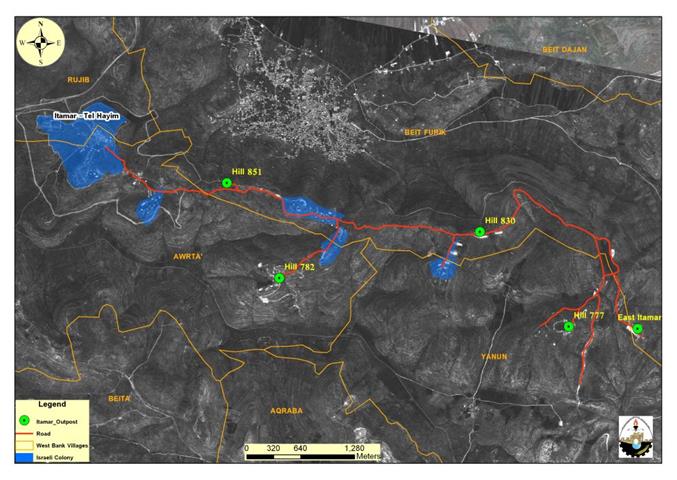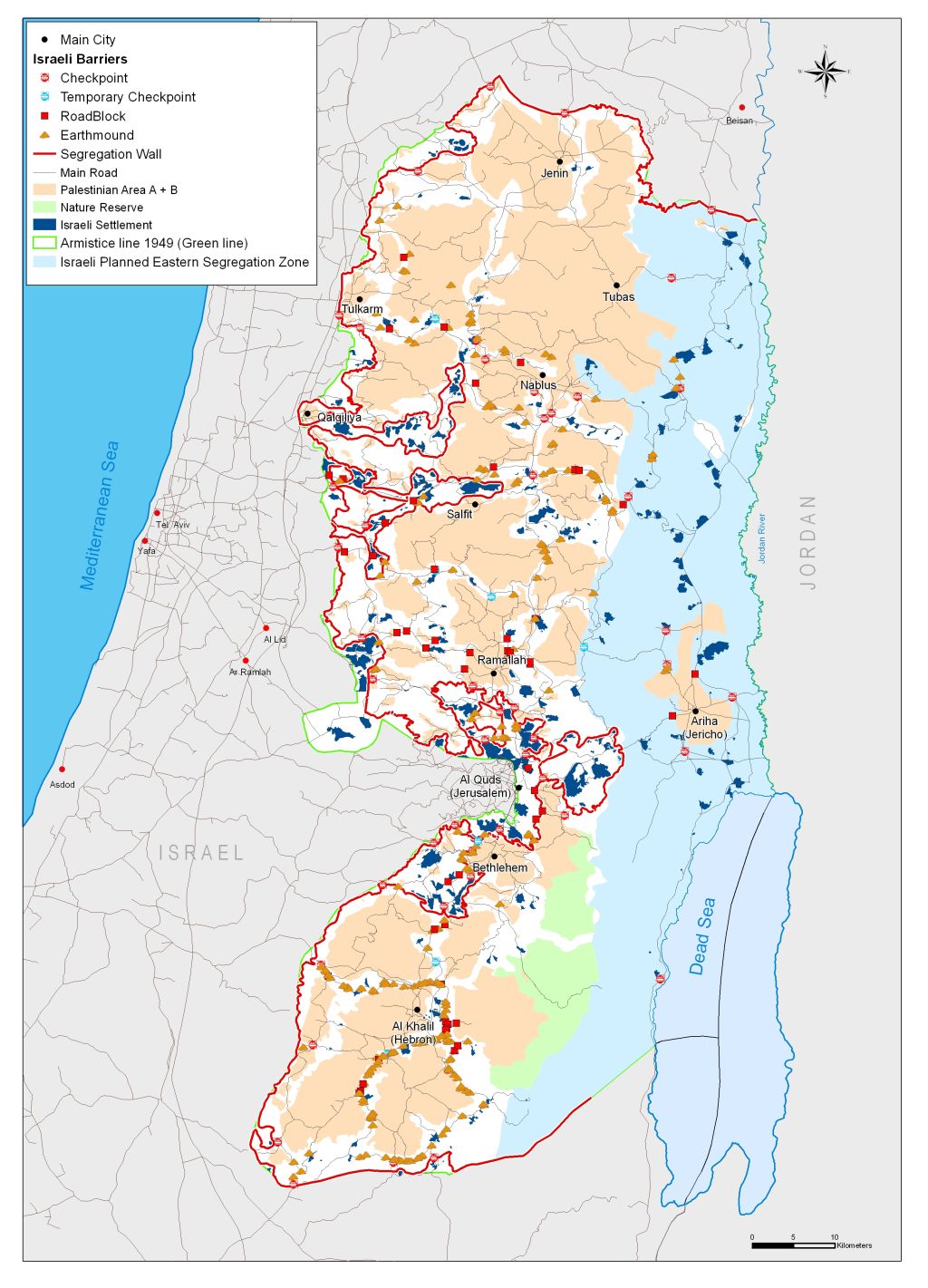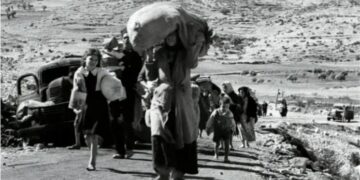The illegal settlement of Itamar lies two kilometers south of Balata and Askar refugee camps on the outskirts of Nablus city. Itamar was established in 1984 as a religious settlement for Orthodox settlers. Today Itamar has six 'outposts' (new settlements) which stretch out towards the Jordan valley. In total, these proto-settlements – together with the parent settlement – have confiscated over 6000 dunums of land from five local Palestinian villages. See map 1
According to article XXXI of the 1995 Oslo agreement, 'Neither side shall initiate or take any step that will change the status of the West Bank and the Gaza Strip pending the outcome of the permanent status negotiations.' Since then most new settlement expansion has been justified under the logic that new settlements are simply 'outposts' of existing settlements, and that it is absurd to halt the 'natural growth' of existing settlements. It is important to note that the concept of natural growth was also disallowed as an excuse for building new settlements in the Oslo accords and the Road Map
Interestingly, although there is a strong voice in Israel which argues in favor of the 'natural growth' concept, the Talia Sasson report (commissioned by Ariel Sharon) clearly states that outposts are new settlements and cannot be claimed as part of the existing 'mother' settlement, and therefore cannot be considered natural growth. In spite of this fact, the logic of 'legal' and 'illegal' outposts (based on the Sasson report) is used by the State to control the expansion of settlements according to its own colonization plans in the Palestinian Territory.
Accordingly, the Israeli government has endorsed only five out of six of the outposts that have sprouted from Itamar. The agreement to endorse these five outposts was made between Ehud Barak and the Yesha settlement council in June 2000, rendering the Sixth outpost 'illegal' under Israeli law. This is a classical example of how the state can subvert the logic of legality to suit its own purposes. Under international law, numerous UN resolutions and the Oslo accords, all of the settlements constructed since 1967 are illegally built on occupied land. It is therefore logically absurd to argue that five of the 'outposts' could be legal because they are in fact attached to the already existing settlement as 'neighborhoods', because the original settlement itself is illegal.
The reasoning behind why certain settlements' outposts would be declared 'illegal' is that by declaring one of the Outposts 'illegal', the Israeli government can make a public show of opposing settlement expansion. By combating and trying to remove the 'illegal' outpost the world media has had the opportunity to see the government actively trying to remove outposts. In the media show generated by the visual footage of ultra orthodox Jews settlers being chased out of a settlement by Israeli soldiers, it is easy for the viewer to forget that whilst number of outposts have been 'evacuated' over a number of new ones have been built. All the viewer will see is 'Israel evacuating settlements', whilst in the mean time, Itamar has successfully secured itself a corridor (see map 2) through Palestinian land to connect it to the Jordan valley which the state intends to annex to Israel according to Prime Minister Olmerts convergence plan'. See Map 2
There is also evidence to suggest that the entire settlement of Itamar would not survive Prime Minister Olmert's convergence plan. This raises further questions as to why the founding of the new outposts was endorsed. It is unlikely that Israel will choose to 'keep' Itamar for the following reasons;
-
The settlement has a very small population with just over 557 people. This means that the repercussions the state will have to face from the settlement movement, a political force in Israeli politics, would only be small.
-
Itamar's location makes it a strategic nightmare to defend. The settlement itself is relatively isolated from the main settlement blocks in Palestinian Territory. At the same time, it is located only 2km from two refugee camps on the outskirts of Nablus city. This means that as long as the settlement exists, it will remain a focal point for friction between Israeli settlers and the Israeli Army on one side and the Palestinian populace on the other.
-
Maintaining the settlement would therefore require a large commitment of Israeli Military ground forces. It has been noted by many commentators that reducing the size (and therefore cost) of its ground forces is one of the main reasons for withdrawal into large settlement blocks.
According to this logic, the State's sanctioning of Five of Itamar's outposts would seem to suggest that the State is interested in 'keeping' Itamar – a small, isolated agricultural settlement on the outskirts of the largest Palestinian city in the West Bank – at great expense to its own resources The settlers of Itamar are known as 'religious settlers' and have a reputation for being ultra nationalist in their political views. Allowing them to expand and solidify their settlement, which may have to be forcibly evacuated later, at first seems to make little sense. However, for an alternative interpretation we can look to the government's strategy in the Gaza withdrawal.
During the Gaza withdrawal in August 2005, Israel managed to make a large amount of political capital by pretending that it was difficult to withdraw only 8500+ settlers from the Gaza Strip. For weeks before the withdrawal, the media was filled with predictions that there would be civil chaos and that the resistance of the settlers could even spark a civil war. This allowed Ariel Sharon (Israeli prime minister at the time of the withdrawal) to present himself as the man of peace who was nobly fighting to withdraw for the sake of peace. We can assume, from the expansion of Itamar that the state intends a similar show this time around.
If Itamar is removed, the Israeli state will have saved itself massive amounts of resources that it would of have to have deployed for its defense. However, due to the extremist's nature of the inhabitants of the settlement, a certain amount of resistance is to be expected from the settlers (as is the case with the smaller outpost). This will allow the state to prove to the world that it is fighting a brave battle to forcibly withdraw the settlers at the great personal risk and expanse of the state.
Why would the Israeli state wish to publicize this point? The reason can be found in the fact that they intend to keep all of the large illegal settlement blocks built on Palestinian land. By fabricating the myth that the withdrawal of one small settlement is a difficult and near impossible task, it can claim that it needs to keep the largest blocks due to the impossibility of being able to withdraw them.
Conclusion
This argument is absurd as the majority of those settlers living in the large blocks are classified as 'economic settlers' which means that they only choose to live their because of the incentives that the state gives them to do so. A 2002 survey has shown that, 77% of the Israeli settlers in the major settlement blocs only chose to live in the settlements for 'quality of life' reasons. This is due to the substantial living subsidies which the government offers in order to encourage settlement construction. This fact can be covered by staging 'difficult withdrawals' of settlements like Itamar so that the world can see how boldly the state is willing to act to try and achieve peace. Endorsing the five new outposts can be understood in this context, by allowing the settlers to build these outposts they have allowed them to get more entrenched, but more importantly; they have allowed the settlers to believe that they will be allowed to stay. This means that when the government attempts to pull them out, resistance will be fierce and Israel will have the political capital of the fighting to present before the world as a demonstration of its 'peaceful intensions' – being willing to fight its own people to achieve peace.
Table 1: Itamar Settlement data.
|
NAME |
Itamar (including Itamar1,2,3,4) (Tel Hayim) |
|
Establishment Date |
1984 |
|
DISTRICT |
Nablus |
|
TYPE |
Religious |
|
AREA 2005 |
2992501.763 |
|
POP_2005 |
557 |
Source: ARIJ Database 2005
:::::::::::::__
[1] The 'Road Map' peace plan was first proposed by American President George W Bush on 24th June 2002 and was endorsed by the Quartet of international powers (United Nations, European Union and Russia).
[2] The 'Sasson report' was released on 8th March 2005
[3] Survey of 500 settlers whose communities are on the Palestinian side of the Segregation Wall and 500 Israelis nationwide conducted by the Israeli firm TNS Teleseker in November 2005 for the One Home Movement.
Prepared by
The Applied Research Institute – Jerusalem
ARIJ













